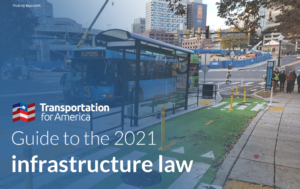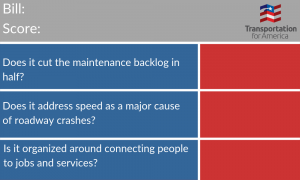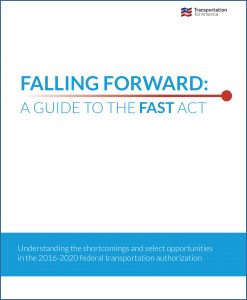Understanding the 2021 infrastructure law
 The $1.2 trillion Infrastructure Investment and Jobs Act (IIJA), passed in November 2021, now governs all federal transportation policy and funding through 2026. (You’ll frequently hear “infrastructure law” or “bipartisan infrastructure deal” as shorthand for the IIJA.) This mammoth bill was the final product of congressional negotiations in 2020 and 2021 over long-term transportation proposals, as well as a standalone infrastructure bill. The final product turned out to be an amalgamation of both.
The $1.2 trillion Infrastructure Investment and Jobs Act (IIJA), passed in November 2021, now governs all federal transportation policy and funding through 2026. (You’ll frequently hear “infrastructure law” or “bipartisan infrastructure deal” as shorthand for the IIJA.) This mammoth bill was the final product of congressional negotiations in 2020 and 2021 over long-term transportation proposals, as well as a standalone infrastructure bill. The final product turned out to be an amalgamation of both.
T4America has produced a wealth of content about the infrastructure law, but we know that federal transportation policy can be intimidating and confusing. So start where you feel most comfortable.
Choose your starting point:
I’m new to the IIJA—catch me up
T4America covered every step of the process that led to this law, from the very first long-term transportation proposals in 2019, all the way to the final product in November 2021. These five posts are our most succinct look at the final product, the IIJA.
- What did we think of it? Read our November 2021 statement on the law’s passage.
- Summarize the law in a few bullet points. Here are five specific things you should know about the law.
- How much money, and for what? This broad financial breakdown shows where the money is going.
- Flaws aside, what’s worth celebrating? There is still potential in the bill worth noting.
- The bill can still be improved through implementation by the administration. And lastly, Biden’s USDOT can improve the bill’s outcomes with administrative actions.
Money: how much, how much more, and for what?
About 54 percent ($643 billion) of the law’s $1.2 trillion total goes toward surface transportation, into a massive five-year authorization (through 2026) of federal transportation law that’s nearly twice the size of the FAST Act that it replaces. The rest goes toward other non-surface transportation infrastructure needs. Two-thirds ($432 billion) of that $643 billion is flowing to conventional highway programs. And when compared to the previous five-year law, the new infrastructure bill increases highway program funding by 90 percent, transit funding by 79 percent, and rail infrastructure funding by 750 percent.
Go deeper: The law’s policy and funding by topic:
Each of these longer topical explainer posts explore a core issue area and unpack the funding and policy that will impact each one. They include recommendations for how the administration can improve the law in implementation, guidance for how advocates can use the new funding, and a brief roadmap of the funding opportunities by program.
Competitive grant programs
The infrastructure law both made enormous changes to competitive grant programs and provided billions of dollars for them.
More than $200 billion of the $643 billion stays with USDOT to be awarded via competitive grants to states, metro areas, and tribal governments—through dozens of newly created, updated, and existing competitive grant programs.
- Get started: Read our high-level overview of how much competitive funding there is, why it matters that USDOT has some control over which projects get funding, and a few notable programs to pay attention to for various reasons—good and bad alike.
- Positioning for grant success: Thinking about applying for competitive funding? Read our three key strategies to prepare a successful application.
- Members-only guide to grant programs by eligibility and use: T4A members can use this guide to locate the federal grants available for their projects and make a case for funding.
Other helpful resources
Many others have created resources to help states, metros, and advocates figure out how to use the IIJA funding. This area includes a curated set of resources that are worth your time to explore.
- Funding table for transit projects. This table was produced in conjunction with TransitCenter and the National Campaign for Transit Justice.
- White House IIJA implementation guide for transportation. This is the White House’s official guide to the IIJA. It’s got their spin on the overall bill, but it’s incredibly detailed.
- Here’s the FHWA’s guide to the IIJA. A step more complex than the White House guide above, this hub from FHWA is geared toward implementing the law. Guidance, fact sheets, funding notices, etc.
- USDOT resource on flexible funding for transit. Curious how FHWA funds can be leveraged to improve bicycle, pedestrian, and transit infrastructure? This webpage offers information and guidance for project sponsors, localities, regions, state DOTs, and transit providers.
- What should cities expect from the IIJA? This five-page guide from the National Association of City Transportation Officials (NACTO) is the best top-line summary of funding and key policies for cities.
- How do transportation decisions get made? The guide, a product of the USDOT Leadership Academy, is an incredibly helpful primer for getting started. More resources from USDOT’s Leadership Academy are available here.



























